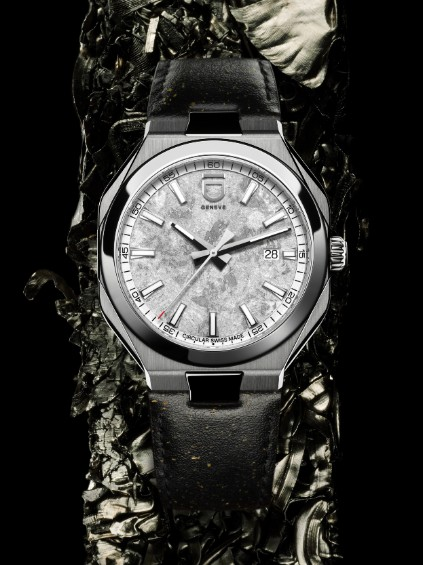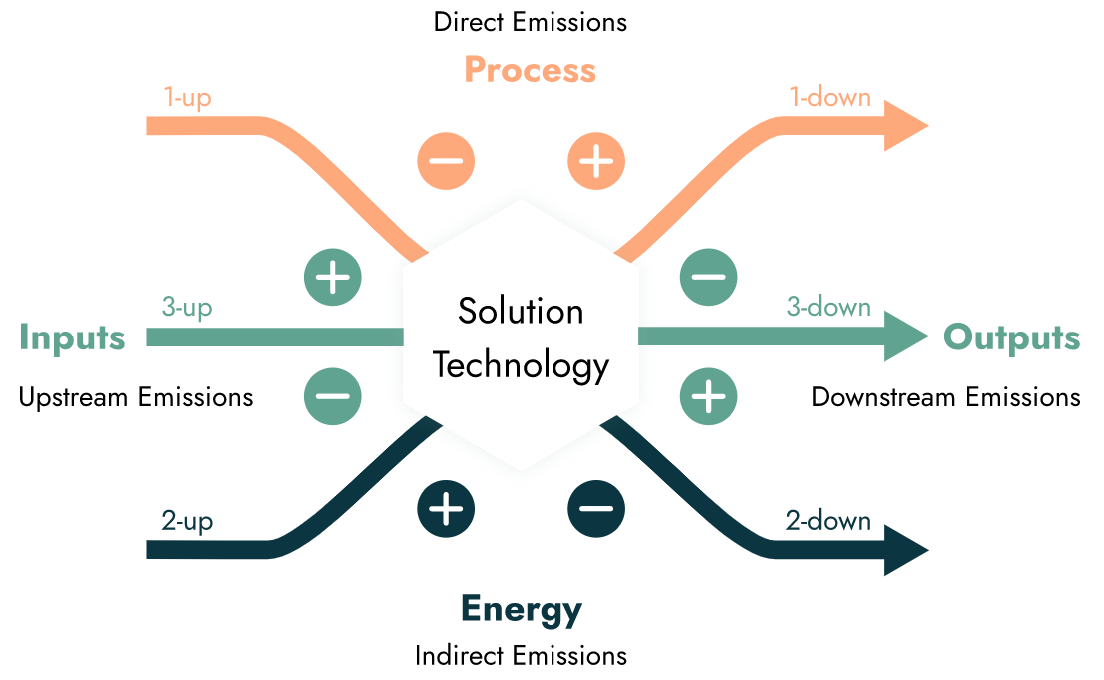

Life Cycle Analysis Circular 1 Watch Comparative analysis against standard stainless steel and gold watch Direct Product Solution  ID Genève is a Swiss watch brand that integrates sustainability and circular economy principles into its designs. The Circular 1 watch is crafted with an emphasis on reducing environmental impact, using reprocessed stainless steel and modular components to facilitate repair and disassembly. The brand also incorporates natural and environmentally friendly materials in its production processes, reflecting its focus on responsible sourcing and manufacturing. This Life-cycle Assessment (LCA) report analyzes the Circular 1 watch model through its entire lifecycle, from cradle to grave. It covers key phases such as raw material extraction, manufacturing processes, transportation logistics, the usage phase, and the product's end-of-life management, including disposal or recycling. The report evaluates critical environmental factors like energy consumption, carbon footprint, water usage, and waste generation. By quantifying these impacts, the LCA offers a detailed understanding of the watch’s overall ecological footprint and highlights areas for potential improvement. The analysis provides valuable insights into how ID Genève can continue to refine its sustainability efforts, while offering transparency in its product’s environmental performance. It is important to clarify that this report quantifies the avoided emissions associated with the production of one Circular 1 watch from ID Genève by conducting a 1:1 comparison with the same watch model made from gold and standard stainless steel. Avoided emissions refer to the reduction in greenhouse gas emissions achieved by choosing more sustainable materials, in this case by sourcing reprocessed steel instead of standard stainless steel and excluding the use of gold. In this context, the report highlights the emissions that would have occurred if ID Genève had followed a conventional production approach, showing how these emissions are avoided through conscious material choices. Therefore, the avoided emissions represent the difference between producing a traditional watch model and the more sustainable Circular 1 watch, demonstrating the tangible climate benefits of ID Genève’s material sourcing decisions. Index
Analysis ParametersGoal and scopeFunctional UnitUnit of circular 1 Watch The functional unit is the assembly of one Circular 1 watch model. BenchmarkGold-based watch This benchmark reflects the Circular 1 watch model produced using conventional raw materials, including gold, plastic, and cow leather straps. Similar assumptions were applied as with ID Genève's watch profile, with the gold presumed to be sourced from Australia, one of the world's leading gold-producing countries. Standard stainless steel - based watch This benchmark represents the manufacturing and assembly of a conventional watch made from standard stainless steel, as opposed to the recycled steel provided by PANATERE. Furthermore, it is assumed that the stainless steel used in this benchmark is sourced from China. Reference flowThe reference flow is the the Circular 1 watch model, with its specific raw material components. GoalThe goal of the LCA is to estimate the environmental impacts associated with one Circular 1 watch model assembled, conducting a cradle-to-grave analysis and a hotspot identification; thus, not only to calculate the impacts but to analyze where the main impacts are coming from in the value chain. Reason for studyThe findings from this study will aid decision-making. By highlighting carbon emission hotspots, ID Genève can concentrate its efforts on them to decarbonize the value chain of its solution. AudienceThe intended audience of this study is ID Genève and its strategic stakeholders, including impact investors and key clients. ScopeSystem BoundaryThe system boundary is drawn around from the raw material sourcing for the Circular 1 watch model to the end of life of the equipment. The cradle-to-grave analysis includes processes such as raw materials for the equipment, its transportation, manufacturing, infrastructure, and packaging as well as downstream processes like transport to customer, repairs and maintenance and waste management. Similarly, the incumbent technology is analyzed under the same boundaries. LifetimeAs the watch has exchangeable and recyclable parts, its estimated overall lifetime is around 100 years. MethodologyMeeting international standardsThis analysis adheres to Lifecycle Assessment (LCA) methodologies outlined in ISO 14040, 14044, and 14067, ensuring a structured approach, potential comparability between solutions, and transparency for readers. The report is based on data available during the study and within the agreed scope. Results reflect the best available data and methodologies, with accuracy and reliability dependent on data quality and completeness at the time of the study. Limitations or uncertainties in the data are explicitly stated. The data used is precise (considering uncertainties and variability), complete (capturing all inflows and outflows within system boundaries), representative (aligned with geography, time, and technology), and consistent. It should be noted that LCA results depend on system boundaries, allocation methods, data quality, and assumptions; where deviations may affect outcomes. ClimatePoint impact analysts herein apply professional judgment and relevant standards while maintaining client confidentiality. Cut-off CriteriaThe cut-off criteria used follows the Allocation, cut-off, EN15804' system model from Ecoinvent database. According to this criteria, all significant inputs and process must be included in the assessment. Inputs or flows which contribute to less than 1% of overall impacts might be excluded. However, it might occur that specific processes or inputs are not accounted for due to lack of data at the time of assessment. These possible exclusions are described in the section 'Assumptions and Limitations'. Allocation procedureThe allocation procedure used in the assessment also follows the 'Allocation, cut-off, EN15804' system model from Ecoinvent database, which is in compliance with ISO 14044. In this procedure, physical relationships (such as mass or energy) are prioritized. When physical relationships aren’t feasible, economic allocation (based on market value) are used as a secondary approach. Impact assessment and impact categoriesThis assessment followed the Life Cycle Impact Assessment (LCIA) method ‘EF v3.1. EN15804’ from Ecoinvent, a midpoint impact assessment method, covering 16 different impact categories. It follows the COMMISSION RECOMMENDATION (EU) 2021/2279. The impact factors for each flow and process were extracted from the ecoinvent database for each of the impact categories for the quantified flows and processes. The GHG emissions were calculated based on the GWP 100, following ISO 14067 standard. Emission factors for each process were extracted from Ecoinvent. Data QualityTechnology coverageThe various data points take into account the best available technology information based on emission factors primarily sourced from the most recent version of the Ecoinvent database. Temporal coverageThis data is assumed to be representative and valid for the entire duration of the production projections covered in this report. Regular updates to the LCA may be necessary to ensure its continued accuracy and relevance. Geographical boundaryThe data has been collected for Switzerland, which is the country where the raw materials are being sourced from and the production plant is located. The clients are located globally, for which the amount of kilometers from the production plant to the client location is accounted. Assumptions and limitationsThe emission factors specific to new, alternate materials in the market (such as recycled steel, vegan leather straps and others) have been excluded due to a lack of data for the same. These must be updated with an EPD or LCA from the suppliers of these new materials. External reviewThis study has not yet been reviewed by a third party external verifier. Functional UnitUnit of circular 1 Watch Executive SummaryKey revelations
Climate Value PropositionID Genève is reducing its carbon footprint through three primary strategies:
These combined efforts reflect their commitment to a circular economy and transparent, sustainable practices. Life Cycle OverviewUnderstanding your emission profileThis process summary depicts an overview of the most significant emission factors that take place throughout your lifecycle activity. By viewing these intensities alongside each other, you can gauge their relative importance with respect to positive and negative extremes. Each process item listed on the horizontal axis will be described further in the Scope Allocation Analysis where readers can dive into the details behind each of the data points. While this model represents the complete overview, we make sure that each factor is supported by a sound methodology. Building your impact foundationSome process items may remain blank because the ClimatePoint team has considered them to be out of project scope, insignificant, or without enough information to analyse. These gaps should eventually be completed as you aim for your emission profile to approach higher levels of accuracy. Because of this presentation, you can understand which additional data is necessary to complete your entire impact profile and accommodate the dynamic growth and scalability of your company. ClimatePoint is here to help you navigate this pathway and optimize your impact strategy. Benchmark: Gold-based watchImpact Category: Climate change Benchmark: Standard stainless steel - based watchImpact Category: Climate change Process Overview Connecting academia with businessThe scope allocation analysis is the ClimatePoint strategy to bridge the LCA emission assessment to the world of corporate GHG reporting. When our team approaches a new technology, we start with the most significant aspects that outline both your generated emissions and your avoided emission impact. The following process items represent these key factors backed by a defined methodology approach. This format permits the technology to be strategically aligned with our global climate targets, challenged for verification, and refined with evolution and growth. As the climate solution matures, we can easily update or add process items making this a truly dynamic report. This ClimatePoint approach integrates impact foundations outlined by the international community. To help you interpret the key climate aspects of your technology, we assign each process item two labels to serve as high level indicators. Your most significant climate impactThe "Score" evaluates processes based on comparative impact: Aligned signifies measurable emission reductions compared to the benchmark; Potential suggests possible alignment pending further verification; Negative denotes additional emissions; Rebound identifies emissions that would have otherwise not occurred with the benchmark; and None represents qualitative assessments. The "Priority" label ranks processes by importance: High indicates critical processes essential for achieving key sustainability objectives, warranting immediate attention; Medium represents processes contributing to the impact profile that require attention but lack urgency; and Low applies to supplementary processes with less immediate impact or those already aligned, allowing deferred action until higher-priority tasks are addressed. # Process item Scope Score Priority Impact AnalysisFunctional unit profileThis graph represents the aggregation of all the aforementioned emission factors with respect to the defined functional unit. By selecting a benchmark, the corresponding avoided emissions will also be displayed on the graph. This enables you to see the difference in the emission profile that this climate solution has to the incumbent technology. There is also an effect filter to identify which impact factors only occur once and which recur multiple times, usually throughout the lifetime use of the product or service. You can click the process labels in the legend to hide and show different elements to reveal further insights.
|
ClimatePoint Funding the Future ClimatePoint AS Universitetsgata 12, 0157 Oslo |
  ClimatePoint AS, Universitetsgata 12, 0157 Oslo Follow us on X | Follow us on LinkedIn |